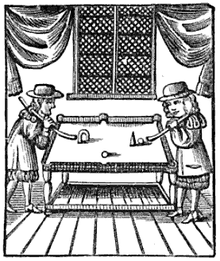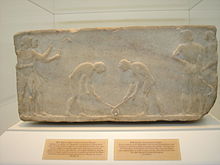Ground billiards
Ground billiards is a modern term for a family of medieval European lawn games, the original names of which are mostly unknown, played with a long-handled mallet (the mace), wooden balls, a hoop (the pass), and an upright skittle or pin (the king).
[4][5] Even in the late 17th to early 18th centuries, indoor billiards was essentially the same game, with smaller equipment and played on a bounded table, with or without pockets.
Ground and table billiards were played contemporaneously,[1]: 36 and the outdoor version remained known until at least the beginning of the 19th century;[3]: 4 derived lawn games like croquet continue to the present day.
[1]: 43 Some contemporary sources depict the same game being played both with the hand and with a mace, and show a distinctive teardrop-shaped king pin design,[1]: 34, 43, 47 with a rounded, wide bottom and a slender top.
[4] Conical king pins are found in depictions and actual surviving game equipment (of carved stone) from Ancient Egypt.[1]: ch.
A similar game has survived to modern times, in the form of box hockey (which uses a flat puck in a confined space, and archways or "mouse holes" cut into wooden barriers, rather than stand-alone arches).
[4] Earlier still, a bas relief dating to c. 600 BCE depicts an ancient Greek ball game, a possible ancestor of both ground billiards and field hockey, which may have been called kerētízein or kerhtízein (κερητίζειν) because it was played with an implement shaped like a horn (kéras, κέρας).
1 Even polo – a cavalry-training sport with origins among the Iranic peoples of the central Asian steppes and directly attested since at least the Parthian Empire (247 BCE – 224 CE) of Ancient Persia – is essentially the same core game as field hockey or team ground billiards, but played on horseback with a longer cue-mallet.
[1]: 35, 49 A set of gaming pieces, buried with a child dating to c. 3300 BCE in Egypt, features stone balls, skittles, and an arch (no cue/mace was included in the recovered artifacts).
For example, in Inner Mongolia in modern-day China, the Daur people have been playing beikou, a game similar to modern field hockey, for about 1,000 years.
It is suggestive that games like ground billiards in the medieval Christian world were for centuries primarily the purview of and preserved by the clergy and the nobility, with peasant game-playing suppressed to the extent possible by many rulers, as unproductive.[1]: ch.
English rules recorded in Charles Cotton's The Compleat Gamester (1674), for an indoor version played on a billiards table, indicate that the general offensive goal of the game is to use a club-like cue, called the mace or tack, to drive one's own ball through a hoop, called the pass, port, argolis, or ring, thus earning a chance to shoot at the upright king pin or sprigg, and to use defensive position play to thwart an opponent's ability to do likewise, e.g. by kissing an opposing ball to an unfavorable location[13][2]: 265 (still a key strategy in many cue sports and lawn games).
Cotton's indoor version made use of pockets in the sides of the table as hazards, with additional scoring opportunities,[13] and some outdoor ground-billiards courts may have used golf-style holes for the same purpose.
The nature of the mace appears to move from crude to elegant over time, with earlier illustrations showing simple hammer- or crook-like implements, with players stooping, while later woodcuts and tapestries show a long, thin device more like a golf putter, and in basic form very similar to later, and more delicate and ornate maces used for table billiards before leather-tipped straight cues became the norm in those games.


